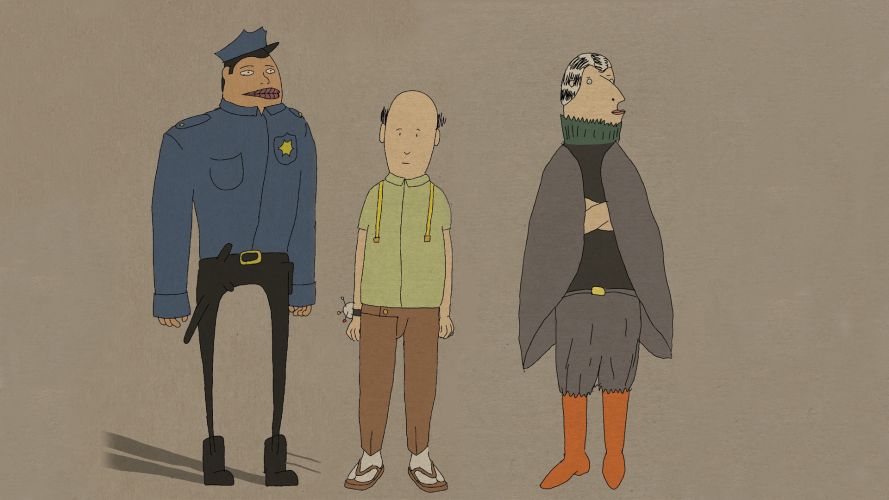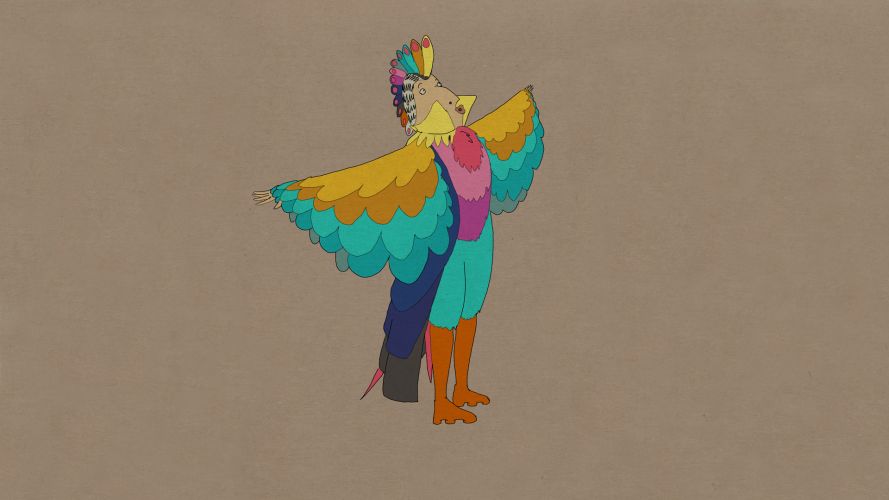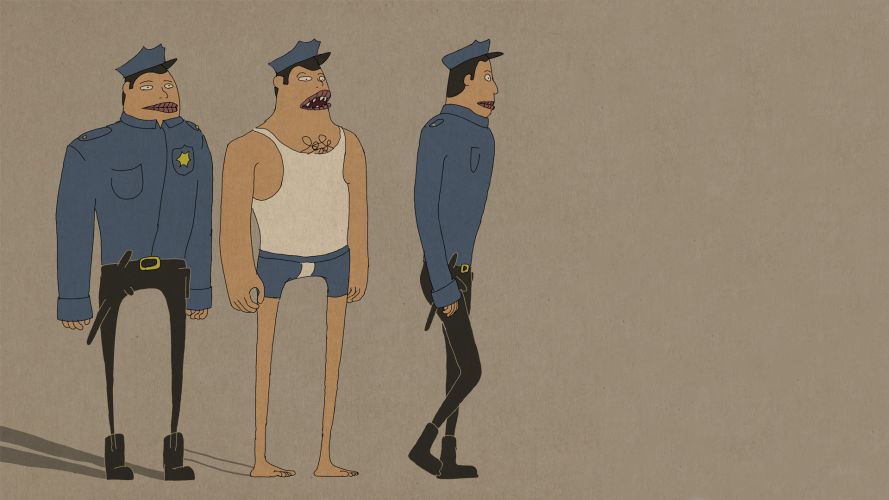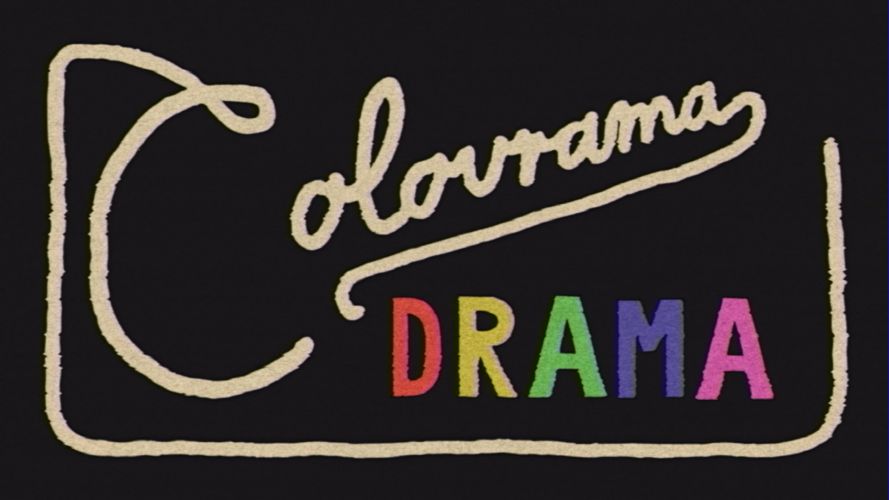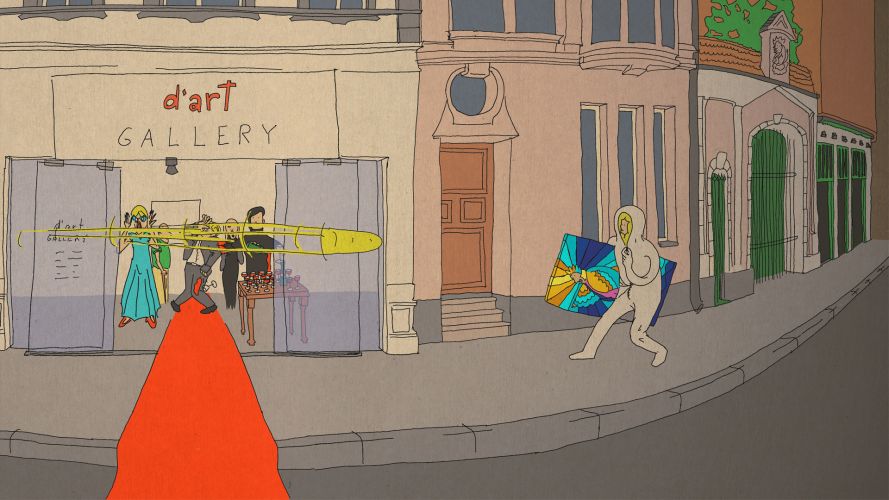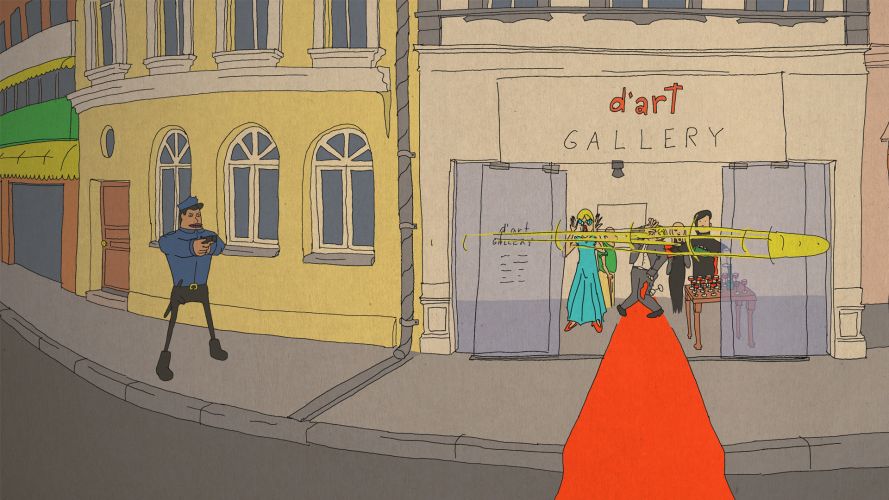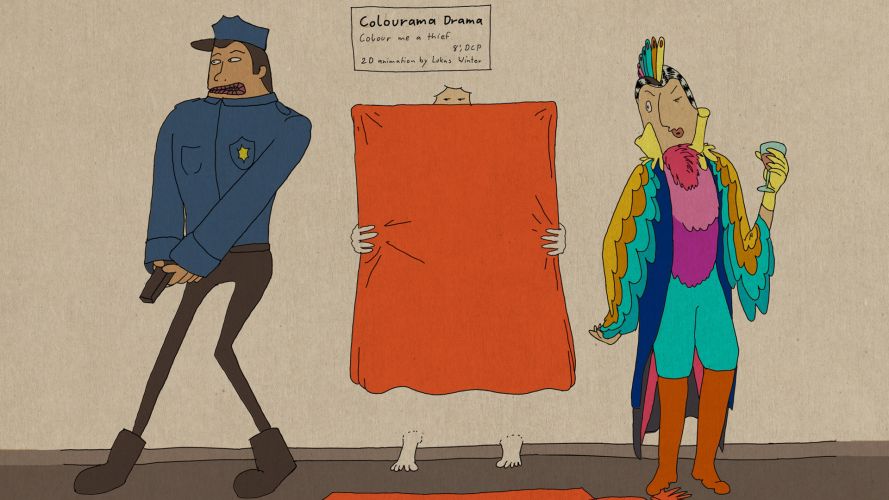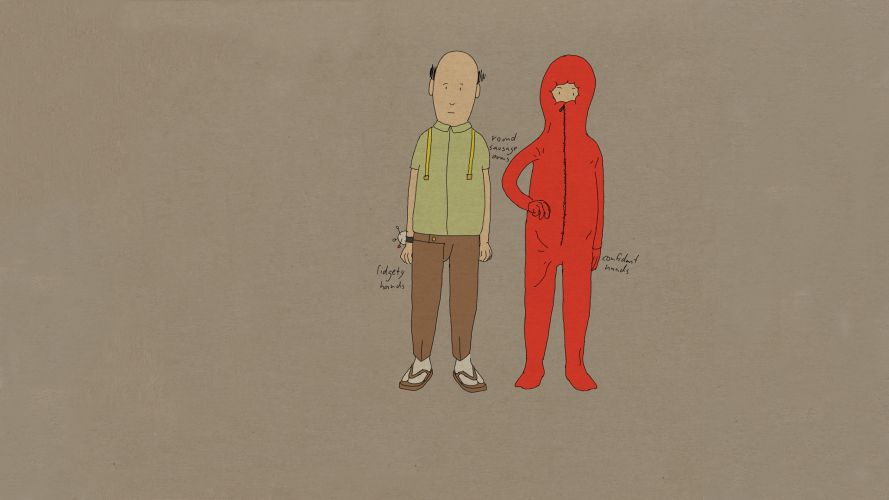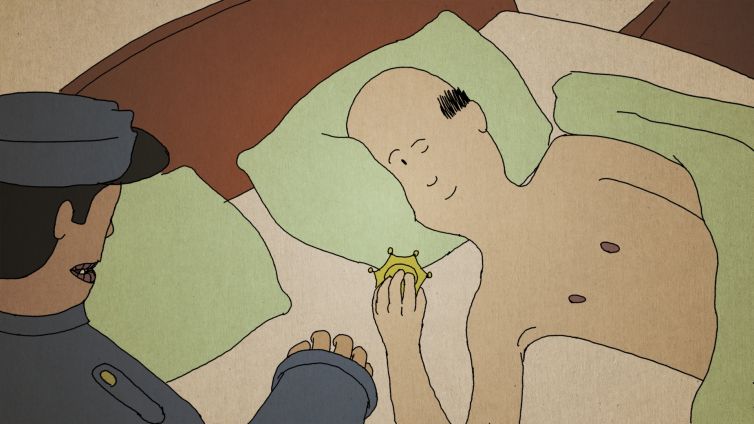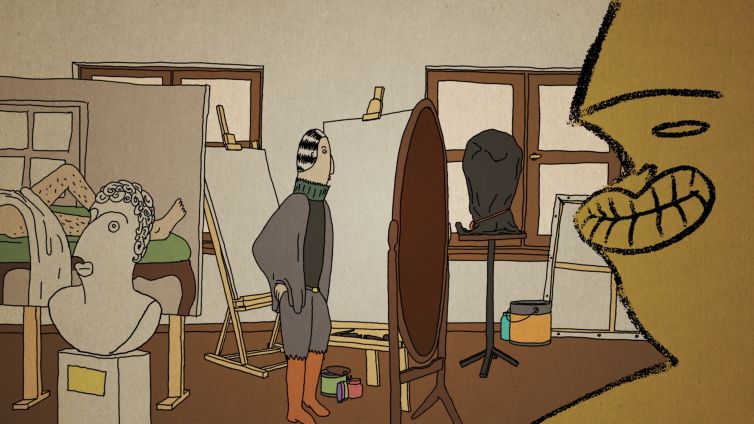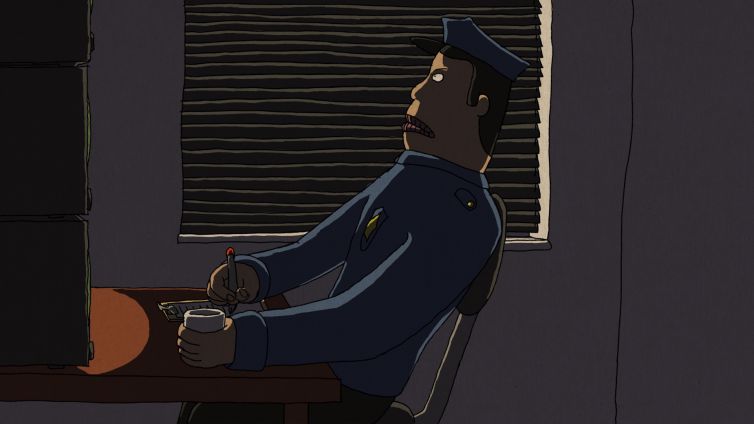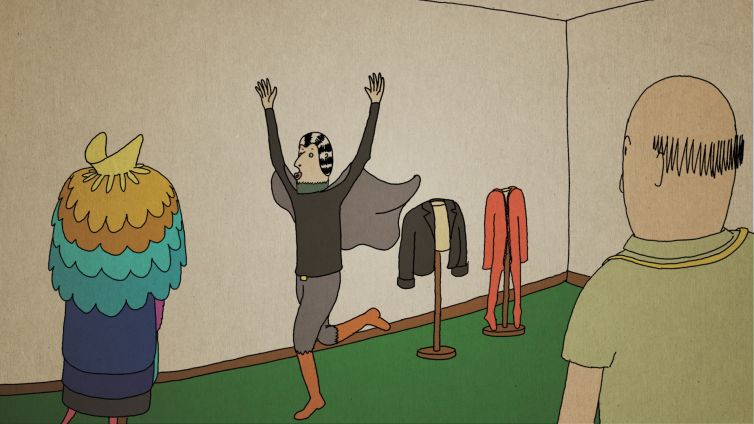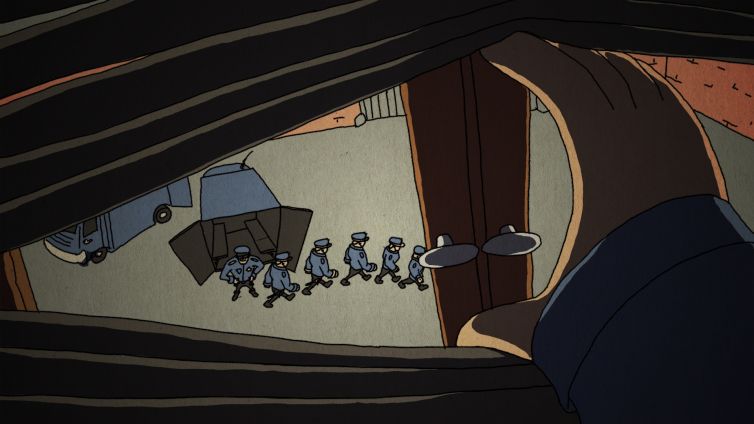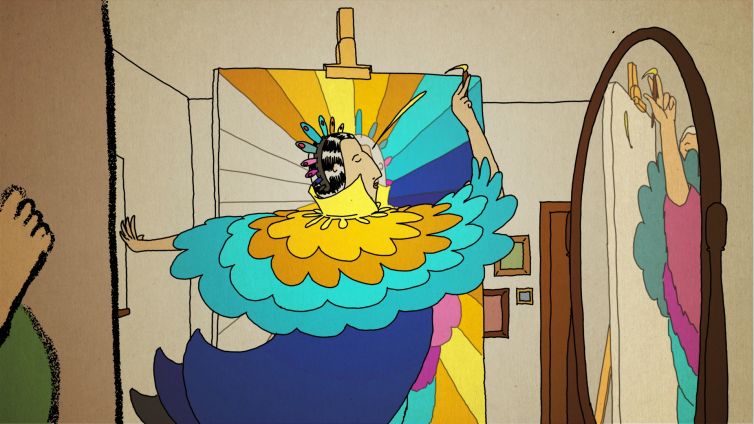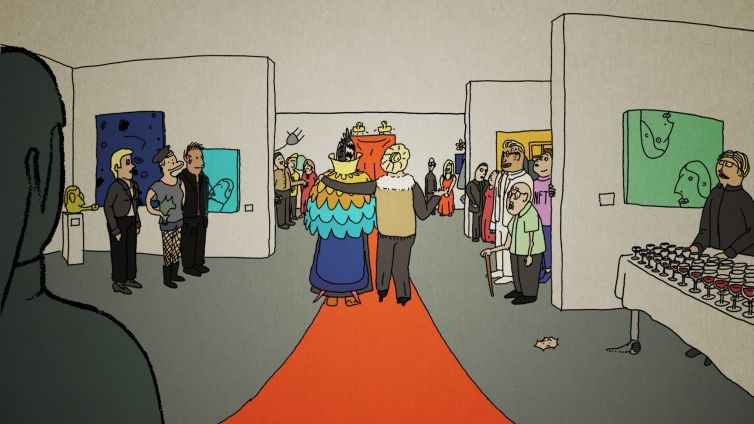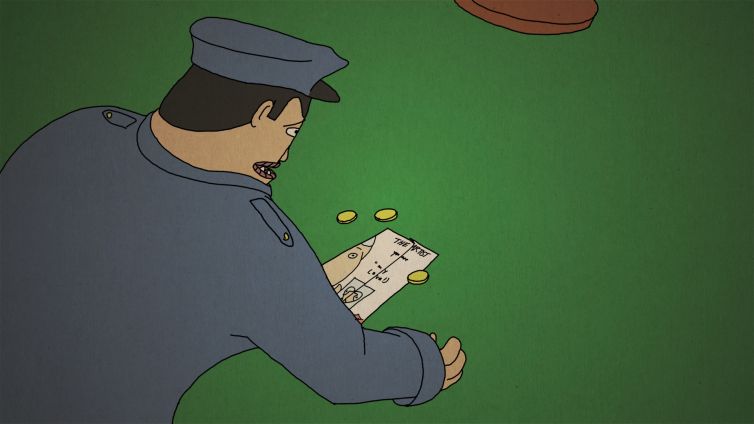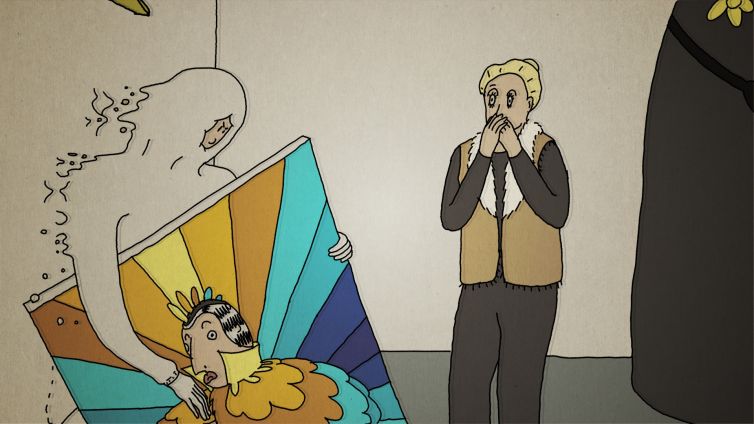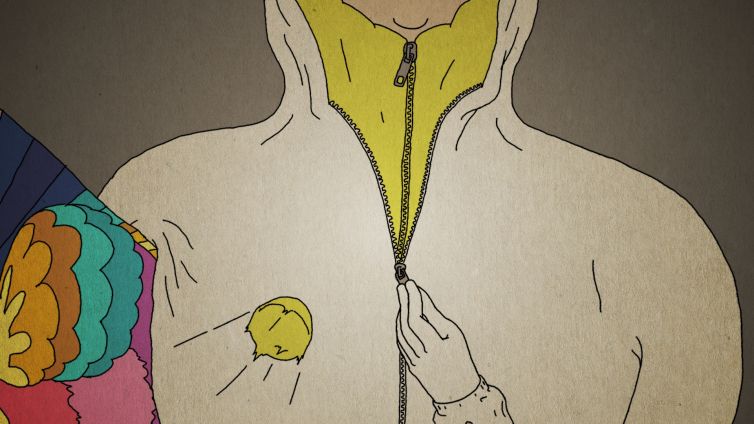narrative digital 2D animation, DCP, 5.1 sound, 8’ 00’’ for teens, young adults and adults
The TAILOR and the POLICEMAN are a couple, but the tailor can’t stop playing tricks on his partner. They live in a world with a small quirk: Objects with equal colours can merge and pass through each other. Enraged by being underpaid by his client, the vacuous ARTIST, the tailor decides to conduct a heist on the exhibition opening in the guise of the mysterious colour thief. But the policeman is also there. Can the thief’s genius outfit save him from the bullet fired from his lover’s gun?
Colourama Drama is an attempt at writing comedy that is simultaneously connected to reality and containing a specific kind of absurdity that is only possible in animation, because it alters the physical foundation of reality. While this quirk of the world inhabited by the characters is the driving force of the plot, they are each governed by their own entirely human albeit exaggerated motives. It is therefore his film’s goal to approach matters of everyday life in a humorous yet surrealistic way.
Colourama Drama is a love story and a story of betrayal at the same time. One of its main themes is secrets. They are part of human nature, sometimes hidden even from our significant other, often hidden in plain sight. Every attempt at hiding an insecurity or a suppressed character trait from a partner is a risk of disappointing them, but so is the act of revealing oneself. The way the couple in Colourama Drama is acting towards each other is a reflection of observations about my own behaviour and that of others in both failed and successful relationships. The story however is neither intended as a good or bad example: Ultimately the characters’ individualities are more deciding on the ending than strictly following the imaginary rules of physics.
The film is also one about unnecessary complications and problems we make for ourselves. This is why the merging of equal colours stays a mere nuisance to almost everybody. The tailor, in his secret identity of the colour thief, however, overcomes the self-imposed limitations of life. The colour thief is intended as the best version of ourselves that we wish we could be, a playful and carefree trickster character that is not bound by everyday complications nor intricate moral deliberations.
The opposite is true for the character of the policeman. He is considered the embodiment of justice, yet condemned by his job to a passive observance of right and wrong. It is important for me to pair up polar opposites on the spectrum of lawfulness and lawlessness in order to address the discrepancies between legitimacy and legality in everyday life.
After all, the film has to be funny as a way of keeping the audience engaged. Besides being constructed as a chain of unfortunate events, the story wants to create intrigue by periodically incorporating small gags based on the premise of merging colours.
The continuous flow of events connected in absurd ways and incredible coincidences, leading to a nevertheless inevitable culmination is an characteristic of Estonian animation that I have come to appreciate during my time of studies in the country.
The characters also draw inspiration from Estonian animation, in particular the films of Chintis Lundgren. The way her animal characters break the boundaries of society through the discovery of their playful side is also reflected in my plot. While I do not use anthropomorphic animals as characters, their design and behaviour borrows some traits from fauna, fish in case of the policeman and birds for the artist.
Stylistically I aim for the look and feel of classic drawn animation, while replacing its focus on smoothness and consistency with a more naive and loose approach that follows from the story and premise. Both visuals and sound can take on an amateurish quality to the extent that it does not obscure the intentions of the plot but serve its delivery in a fast-paced rhythm. For this I also intend to borrow from the looks, style and sound of media from the early 80s and technologies such as VHS and analogue synthesisers.
The premise for Colourama Drama has been with me as an idea for a long time and started from an afternoon discussion with fellow students at the Estonian Academy of Arts about how to construct stories that can only be put on screen in the animated medium. However a plot only started taking shape at the time of beginning my internship in stop motion at Animais AVPL. The studio’s offer to provide me with time and space for the development of this short therefore came at exactly the right moment. It is not just their experience and dedication to animation in all techniques, but also the openness with which I and my ideas were welcomed, that convinced me that Porto is the right place to produce this film.
TREATMENT
The TAILOR and the POLICEMAN are a couple that lives in a world with a small quirk: Objects with equal colours can merge and pass through each other – but everyone considers it a nuisance and nobody has realised the advantages.
The tailor can’t stop playing little tricks on his partner. While the police officer gets dressed in the morning, he has nicked his police badge in a cheeky attempt of initiating an intimate moment. The police officer, however, is not entertained by this, grabs his badge and leaves.
While the policeman is keeping up appearances of fulfilling a tough and respectable job, in reality he has the unsatisfying role of monitoring public surveillance cameras. Looking at the screens in front of him, he starts daydreaming of doing actual police work:
He is chasing a mysterious thief who appears and disappears seemingly randomly. Finally he has cornered the presumed criminal, who is holding an enormous diamond. But the thief suddenly turns into his partner, the tailor, just as the diamond turns into a police badge. At this moment the policeman wakes up. Hot coffee has spilled from his knocked over mug, merging and passing through the same-coloured desk and dripping onto his leg.
Meanwhile the tailor is also daydreaming at his home office and workshop. He has arranged various dyed fabrics and observes how his gloved hand passes through the one equal in colour to his glove. As he is doing so, the vacuous ARTIST arrives to pick up the colourful robe he has ordered. The artist is delighted with the result and demands to try it on immediately. After the tailor has packed the robe his customer is ready to leave but the tailor holds him back. He forgot to pay! The narcissistic artist comes up with a few coins and an invitation to his exhibition opening as the only payment for the tailor’s hard work.
The underpinnings of the tailor’s shenanigans come to light as he indulges in his kleptomaniac tendencies and slips into the home-made outfit of the genius colour thief: He has long prepared a collection of full-body jumpsuits in different colours, which he layers in order to be able to pass through and hide inside floors, walls and furniture. Intent on revenging the underappreciation of his work he infiltrates the exhibition opening and tries to steal the artist’s latest masterpiece, a self portrait in his new robe.
But it just so happens that the police officer passes by the gallery as he returns from work. In the exact same moment two hands emerging from the wall grab the painting and the heist is discovered by the panicked guests. As chaos ensues, the thief tries to run off with the painting. The artist attempts to rescue his work, leaping at the thief, only to accidentally get trapped inside his own painting due to the strange colour-merging mechanics of this world.
The policeman, still unaware of the thief’s identity and eager for action, confronts the burglar in front of the gallery. He unknowingly points his gun at his partner. A shot is fired – but the tailor reveals the final layer of his outfit, a brass-coloured jumpsuit. The bullet merges with it. For a moment, the consequences are unclear, as the policeman recognises the tailor and drops his gun in shock.
Then the gallery guests break into applause. What a marvellous performance! They wrongly believe that the tailor, who is unhurt, was in fact an actor performing his part in a spectacle set up by the artist. They carry the trapped artist and the magic weapon back into the gallery. The savvy gallerist gives it a price tag and they continue with their socialising. Meanwhile the tailor and policeman are left to face their relationship and reconsider their careers. The policeman is now ready to engage with the marvellous mischief of his partner, the colour thief.
Budget: 90.000,00 €




